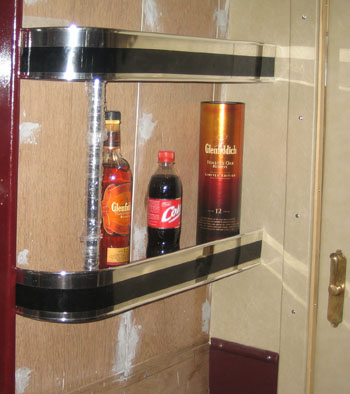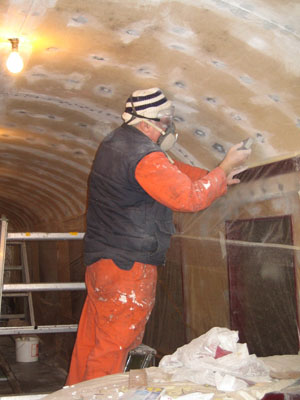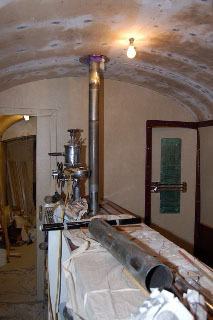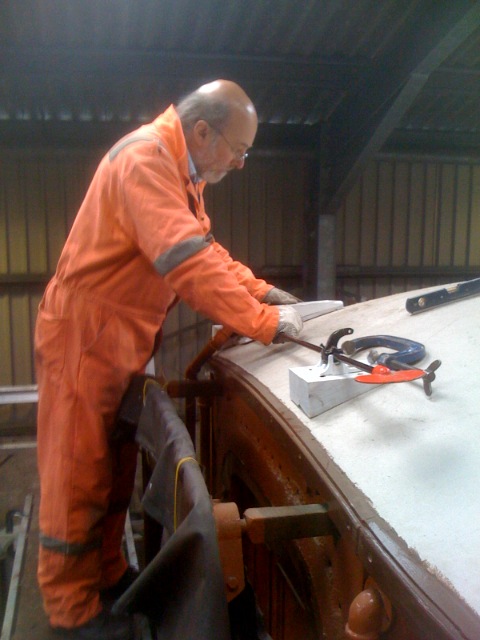
Spring 2008 saw considerable progress both inside and outside the coach.
Don manufactured the bottle shelves for behind the bar. There is a long pair which stretch between the two windows and a
shorter pair which fit between the small window and the sliding door bulkhead. These were constructed from 1" plywood
trimmed on the outer edge with 3" high stainless steel strip. The strip was drilled and countersunk so it could be
screwed to the front (curved) edge of the shelves, then the fixing screws had thier heads filled, sanded off and finally
covered by a 1" wide black vinyl strip to imitate what we had seen in 1936/1937 photos of diagram 167 coaches. As the
stainless steel strip was rather thin, it presented an unacceptably sharp top and bottom edge which would present a hazard
in today's Health and Safety conscious world, so some small chrome edging trim was obtained and has been glued to the
top and bottom edges to remove the hazard.


The painting team set about the unenviable task of papering the saloon ceiling. A great deal
of filling and sanding was required before the surface of the 4mm plywood was smooth enough to apply the paper. The particular
problem area was unsurprisingly where the board sections met. After many dusty hours of filling and sanding, papering was started
from the east end and has reached the end of the bar at the time of writing.
Externally, some more varnish has been applied
to the main coach boarding as and when the weather was warm and dry enough to permit this operation.
The bar rails have
been delivered from our supplier and have been test assembled. They are an excellent fit to the profile of the bar, but will
not be screwed in place until rather more of the internal decorating work has been completed.
Glyn has been manufacturing the flue for the boiler. The internal tube was made by extending an original flue pipe so
that it reached right up into the cowling which sits on the roof above the boiler vent. A complicated spider arrangement was
required to centre the tube as it passed through the roof. The original outer chromed tube which acts as an insulator to prevent
the hot inner flue tube being touched was also extended up to ceiling height by fitting a collar inside the extension which then
seats in the lower part. Thus a constant diameter nicely chromed flue has been re-created.
The flue tubes we have seen in
period photographs vary greatly - some are insulated for the bottom part only, some have a large cowling half way up, and some
show a nicely chromed constant diameter tube all the way up. We have chosen the latter as it is by far the most aesthetically
pleasing.


Passcom parts have been re-mounted on the roof at the west end of the coach. The original mounting blocks for the passcom
valve and shaft disintegrated when they were stripped off prior to re-roofing. At the time, blocks of teak were made up by glueing
thinner pieces together then shaped to as close to the original as possible. When it came to refitting the angled support blocks
it was found that they were not nearly close enough to the original shape, so a great deal of shaping, fitting and climbing up and
down the staging was required before the blocks were an acceptable fit. A generous fillet of flexible paintable sealant was then
piped round the base of the blocks before securing them to the roof boards.
After greasing the shaft and valve components and
checking the mechanical operation of the passcom valve, the shaft bearing covers were screwed into place.
The backs and
bottoms for the saloon seats have been stripped ready for re-uphostery. 4 of the bottoms were found to be beyond saving so new
hardwood replacements have been manufactured and these await assembly at the time of writing. The method of jointing the frames
is by using glued wooden dowelling.